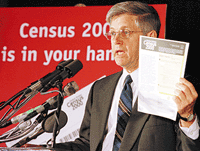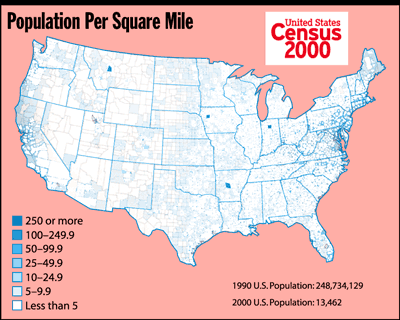

 |
|
| Above: Census Bureau director Kenneth Prewitt. |
WASHINGTON, DC--With the April 1 deadline for returning Census 2000 forms finally passed, the Bureau of the Census announced Monday that the U.S. population stands at 13,462.
"We at the Census Bureau are shocked by the incredible decrease in the population that apparently took place in the 10 years since the last Census in 1990," Census Bureau director Kenneth Prewitt said. "A 1999 projection estimated the U.S. population at 274 million and set the annual growth rate at .95 percent. Yet from this latest Census count, we find that this projection overestimates the population by a multiple of 20,000."Despite the sharp population dip, some data remains consistent with previous censuses. New York remains the nation's largest city, with a population of 664. Los Angeles is a close second with 657, and Chicago a distant third with 329. Surprisingly, the nation's fourth largest city is now Elkhart, IN, with a population of 256. Some suspect that the rise is the result of a citywide "Hey, Elkhart, Come To Your Census!" campaign. The most precipitous decline in urban population was in Houston, TX, formerly America's fourth largest city. In 1990, Houston boasted a population of 1,630,553. In 2000, it is 12.
No one lives in St. Louis.
 |
As a result of the low Census count, hundreds of members of the House of Representatives are now departing Washington. Because the Constitution stipulates that the number of representatives is determined by each state's population, these representatives are finding themselves without the necessary constituents to justify their presence in congress.
"I greatly enjoyed my 20 years in the House," said U.S. Rep. William Skene (R-ID). "Sadly, only one person from my state, Hank, answered the Census, so I will have to tender my resignation." Yet some changes could be beneficial. The nation's Social Security crisis has been solved, with the nation's 7,204 senior citizens dividing amongst themselves $416 billion in Social Security funds. "Last week, I was turned away by the local V.A. hospital," said Warren Costello, 88, a Medford, MA, WWII veteran and diabetes sufferer who doesn't have medical insurance. "But now I can afford my very own jet-powered walker."
Similarly, if the Clinton Administration's education budget request passes, the per-child allotment will exceed $2.8 million. "Gone are the days of 40 children to a classroom," education advocate Marian Wright Edelman said. "Today, the ratio is an estimated 40,000 classrooms to a child." But despite such optimism, some observers are predicting that the low population count will have catastrophic effects on the national and global economy.
 |
|
| Above: Hank Logan, the population of Idaho. |
"Our 13,462 residents will be extremely hard-pressed to match the estimated 1999 gross domestic product of $6.9 trillion, unless each of them works tens of thousands of industrial, agricultural, and service-sector jobs," said Professor M. Russell Harte of Northwestern University's Kellogg School Of Business. "Also, I predict that the importation of foreign goods will plummet by nearly 600,000 percent, and the previously burgeoning consumer economy will experience a violent collapse. And if you consider that most of the Census respondents were aged 65 years or older, it doesn't take long to come to the conclusion that we are doomed."
As experts in countless fields contemplate the potentially disastrous impact the Census results may have on American life, they all arrive at the same question: Why did the American population decline so sharply during the 1990s?
![]()
![]()
Reading Bits Return
Top Return